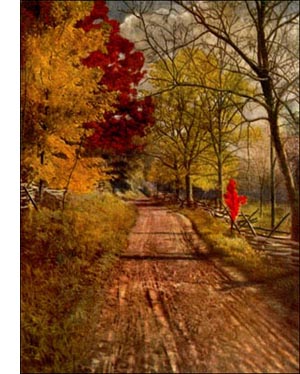Sugar Maple or Rock Maple Tree
 Sugar Maple, Rock, or Hard Maple (Acer Saccharum, Marsh.; Acer saccharinum, Wangh.; Acer barbatum, Michx.)-A large, handsome tree, 75 to 120 feet high, with many upright limbs forming an oval or oblong head. Sap sugary. Bark grey, deeply fissured.
Sugar Maple, Rock, or Hard Maple (Acer Saccharum, Marsh.; Acer saccharinum, Wangh.; Acer barbatum, Michx.)-A large, handsome tree, 75 to 120 feet high, with many upright limbs forming an oval or oblong head. Sap sugary. Bark grey, deeply fissured. Wood reddish brown, close grained, tough, hard. Leaves broad, 4 to 5 inches across, 3 to 5-lobed, each lobe with straight sides and peaked apex, which has 3 to 5 prominent teeth with curved sinuses between; thin, dark green above, paler lining; turn to yellow, orange and red in the fall.
Flowers, with the leaves in late spring, on long stems, in hairy, thick clusters, without petals, greenish; monoecious or polygamous. Fruits, October, 1 to 1 1/2 inches long, smooth, in pairs, on stems, 1 1/2 to 2 inches long, with wings only slightly diverging.
Preferred habitat, rich, moist soil in valleys or uplands.
Distribution, Great Lakes to Newfoundland; south along mountains to Florida; west to Nebraska and Texas. Uses: Best of all maples as lumber and shade trees. Wood used for flooring, interior finish of houses, saddles, furniture, boats, shoe lasts, all turned wares and fuel. Shows occasionally curly grain. Sap makes maple sugar.
The sugar maple is one of the most characteristic and valuable trees in the eastern forests of America. It leads all the other maples-it is the reliable, conservative member of the family, slower than many of them, and less brilliant, but with staying qualities -an absolutely dependable tree. Soft maples come and go. These come and stay-standing always "proud and tall under their leafy crowns." They are hardy, clean and vigorous. They turn gradually to gold and reds in the fall, and drop their burden of foliage without haste.
Hard maple lumber outranks all other species, and as fuel it is surpassed only by hickory. Its ashes yield potash and alkali in large percentages. Fresh unleached hard maple ashes are highly esteemed as fertiliser for orchards and vegetable gardens.
Wise men were they who set hard maples along the boundary lines of their farms in earlier days. They now have avenues to be proud of. And they have also a source of revenue, for these low-branched, isolated trees give abundant flow of sap in the early spring.